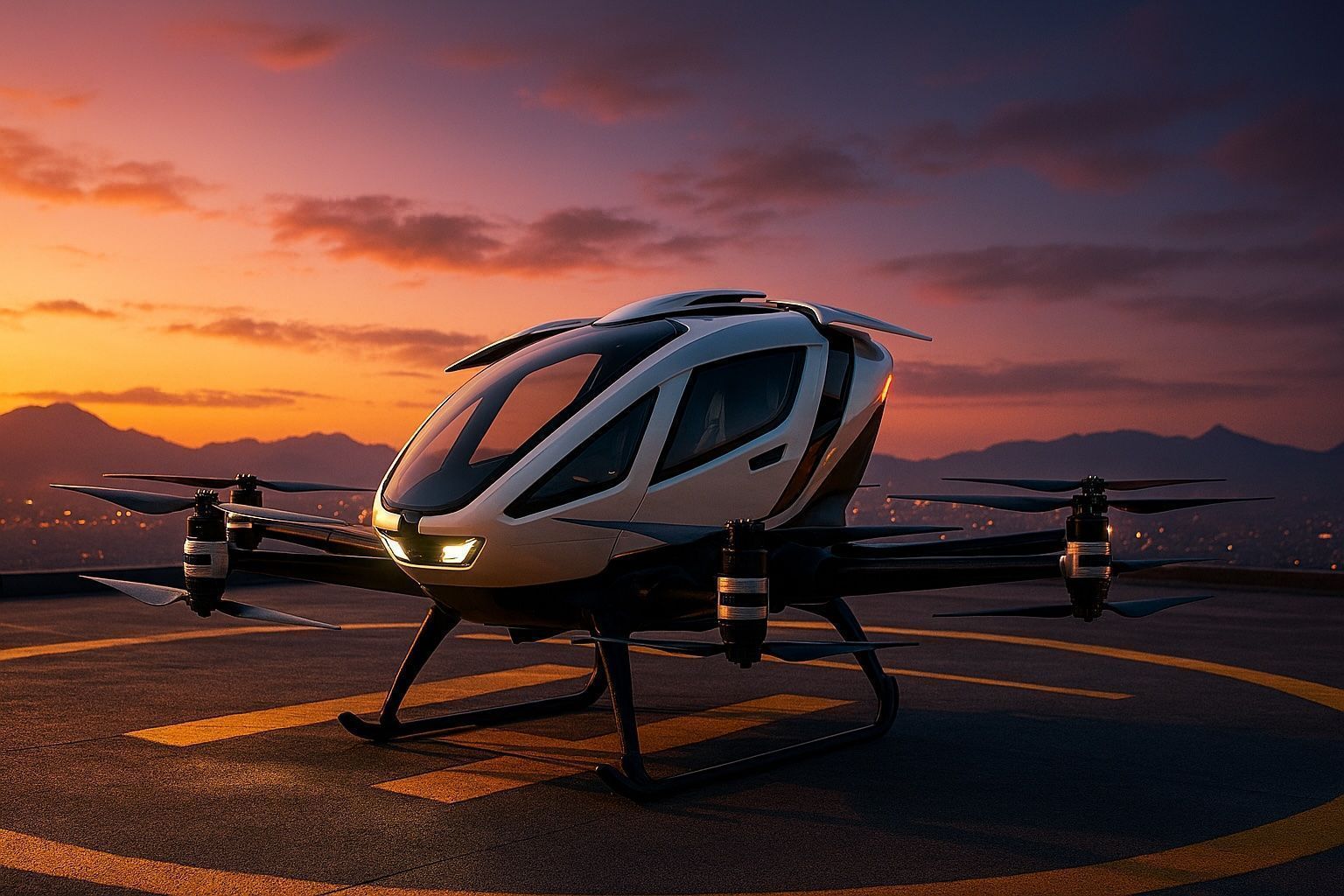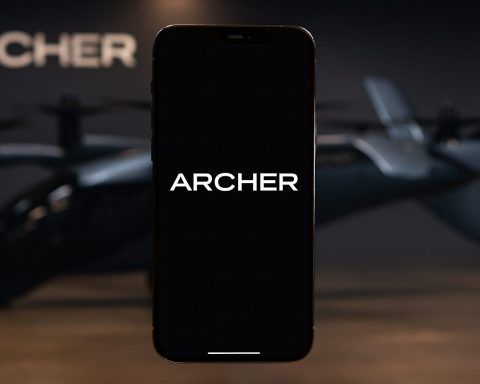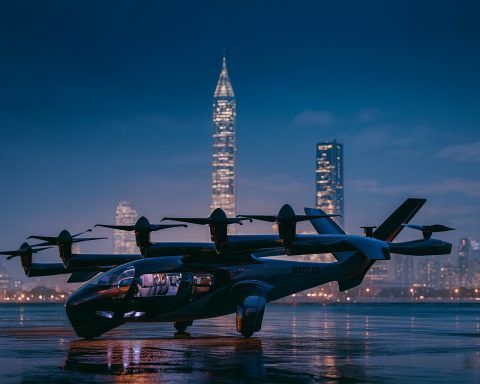- In April 2025 New York City’s Economic Development Corporation unveiled the Downtown Skyport at the Manhattan heliport, the city’s first eVTOL hub.
- As of mid-2025, 92 U.S. cities and airports have active plans for eVTOL operations.
- Abu Dhabi plans to become the world’s first city with a commercial eVTOL service in 2025, with Archer Aviation securing agreements with Abu Dhabi’s government, Etihad Airways, and the UAE’s GCAA to deploy initial city-center to airport routes.
- Joby Aviation’s S4 is a five-seat piloted eVTOL with six tilt-rotor props, designed for speeds up to 200 mph and a roughly 150-mile range, with prototypes having logged thousands of test miles by 2025 and a pilot-launch window of 2025–2026.
- Archer’s Midnight is a four-passenger-plus-pilot eVTOL with a fixed wing and 12 rotors, cruising about 156 mph with a 20–50 mile range (up to 100 miles) on a ~400 kWh battery, initial flight tests completed in 2023–24, and it can operate from an ~18×18 meter pad as it targets certification in 2025.
- Volocopter’s VoloCity is a two-seat eVTOL with 18 rotors, offering about 110 km/h (68 mph) and a 35 km range, and it completed crewed tests in Paris, Singapore, Dubai, Helsinki, and Rome while aiming for EASA certification by 2025.
- Lilium’s Jet is a five- to six-seat eVTOL with 30 electric ducted fans, projecting a cruise speed of ~270 km/h (168 mph) and a 175–250 km range, with certification targeted for 2025 and first customer services around 2026.
- Wisk Aero Gen-6 is a four-seat autonomous eVTOL with 12 lift fans and pusher props, targeting ~120 knots cruise and ~90 miles range, and after a November 2024 FAA Stage 2 G-1 milestone it plans flight testing in 2025 and a 2028–2030 commercial launch.
- EHang EH216-S is a two-seat autonomous eVTOL with 16 rotors, achieving CAAC type certification in October 2023, a CAAC production certificate in early 2024, and March 2025 Air Operator Certificate enabling limited passenger sightseeing flights in Guangzhou and other approved areas.
- The FAA issued a final rule in October 2024 creating a ten-year framework under SFAR to allow initial powered-lift eVTOL operations while permanent rules are developed, with 2026 as the likely first commercial passenger eVTOL approval in the United States.
Introduction
Urban Air Mobility (UAM) – the use of electric vertical takeoff and landing aircraft (eVTOLs) for air-taxi services – is rapidly transitioning from concept to reality in 2025. Around the world, pilot programs are underway to integrate “flying taxis” into city transportation networks. Major aerospace startups and aviation companies are hitting key milestones in aircraft testing and certification. At the same time, regulators are crafting new rules to ensure these services launch safely, addressing challenges from airspace integration to public acceptance. This report provides a detailed look at global developments in UAM in 2025, including leading air-taxi programs, launch cities, technical aircraft profiles, company milestones, and the evolving regulatory landscape.
Air-Taxi Pilot Programs and Launch Cities in 2025
Multiple pilot programs and early commercial launches of air-taxi services are unfolding worldwide in 2025, marking UAM’s transition from experimental flights to limited operations:
- United States: U.S. cities are aggressively preparing for UAM. As of mid-2025, 92 U.S. cities and airports have active plans for eVTOL operations. Major urban hubs like New York City, Los Angeles, Miami, Dallas, Chicago, and San Francisco have developed detailed strategies and are investing in vertiports and support infrastructure. In April 2025, New York City’s Economic Development Corporation unveiled a “Downtown Skyport” at the Manhattan heliport – the city’s first hub designated for eVTOL air taxis. Airlines and operators are vying to be first: Blade (using Beta Technologies’ eVTOL) and United Airlines (partnered with Archer Aviation) have announced plans to run early air-taxi services in NYC, while Delta Air Lines (partnered with Joby Aviation) and others plan routes from nearby New Jersey hubs. Miami is another frontrunner, with several eVTOL developers (Joby, Archer, Eve, and Hyundai’s Supernal) prioritizing it as an initial UAM market. In California, Archer, Joby, and others are developing networks around the San Francisco Bay Area. Though the FAA is expected to certify the first passenger eVTOLs by 2026, U.S. cities are racing to have vertiports and routes ready for inaugural services.
- Middle East: The United Arab Emirates has emerged as an early launch region due to strong government support. Abu Dhabi is poised to become the world’s first city with a commercial eVTOL air-taxi service, with operations scheduled to begin in 2025. California-based Archer Aviation secured strategic agreements with Abu Dhabi’s government and private partners (including Etihad Airways and the UAE’s GCAA regulator) to expedite deployment. “We have all the pieces in place. The technology is there, the funding is there, and now we have the local and federal support scheme,” said Archer’s Chief Commercial Officer Nikhil Goel, noting that an expedited regulatory pathway in the UAE will enable launch “sooner than the rest of the world”. Initial routes in Abu Dhabi will connect key hubs (e.g. city center to airport), and future expansions could link Abu Dhabi and Dubai in minutes [1]. Dubai is not far behind – the city has announced plans to integrate air taxis by the mid-2020s and is collaborating with eVTOL companies. Notably, Joby Aviation is planning to conduct test flights in Dubai in summer 2025 as part of Dubai’s push for advanced air mobility.
- Europe: Several European cities have hosted high-profile UAM demonstrations, though full passenger service is pending certification. Paris, France prepared to debut autonomous air taxis during the 2024 Olympic Games, with German eVTOL developer Volocopter leading the project. While certification delays meant the Olympic air taxis could not carry passengers, Volocopter did conduct successful test flights in Paris during the Games – including a sunrise flight over the Palace of Versailles on the Olympics’ final day (carrying only cargo). Volocopter now aims to secure European Union Aviation Safety Agency (EASA) approval to begin passenger-carrying flights in Paris by December 2024, in time for the city’s next major event (the reopening of Notre-Dame Cathedral). Other European cities are lining up: Rome, Italy saw its first crewed eVTOL test flight in October 2022 using Volocopter’s craft, and a vertiport at Fiumicino Airport is ready for eventual service. Germany (home to Volocopter and Lilium) and UK (through Virgin Atlantic and Vertical Aerospace partnerships) have also developed UAM pilot projects, though these remain in testing phases pending vehicle certification. European launches have faced some public resistance – for example, local officials in Paris filed legal action calling the Olympic air-taxi project “an environmental aberration for the ultra-rich” and seeking to halt flights until impact concerns (noise, visual, carbon) are addressed. Despite hurdles, Europe’s UAM industry remains optimistic: EASA has been actively laying regulatory groundwork, and industry rivals are now looking to the Los Angeles 2028 Olympics as the next target for showcasing urban air taxis on a world stage.
- East Asia: In Japan, the government is embracing UAM in conjunction with Expo 2025 Osaka. Japanese eVTOL startup SkyDrive and others plan public demonstration flights during the 2025 World Expo, supported by new vertiport infrastructure at the Expo site. Earlier, Joby Aviation conducted an exhibition flight in Japan (in partnership with Toyota and ANA) as a demo of future air-taxi services. South Korea launched the K-UAM Grand Challenge, a government-organized program where eVTOL developers (including Joby) performed test flights to validate air taxi concepts in Korean airspace. China is arguably leading in early UAM operations. Guangzhou-based EHang became the world’s first eVTOL company to receive a type certificate for a passenger aircraft, and by late 2024 Chinese regulators had granted it an initial commercial operations license. In Hubei province, EHang’s autonomous two-seat drones have been undergoing pilot tourism flights at a scenic lake, and a company representative stated that full commercial passenger flights could begin as early as spring 2025 once final approvals are in place. Indeed, in March 2025 the Civil Aviation Administration of China (CAAC) issued the world’s first eVTOL air operator certificate to EHang’s subsidiary, initially permitting limited passenger sightseeing flights in Guangzhou and other approved areas. This makes China the first country to officially authorize revenue-generating urban air taxi services (albeit on a small scale).
Leading Air Taxi Aircraft: Technology and Operational Characteristics
The eVTOL aircraft at the forefront of UAM in 2025 share common goals of zero-emission flight and vertical takeoff/landing ability, but they vary in design and capabilities. Below is an overview of some prominent air-taxi models and their technical profiles:
- Joby Aviation S4 (USA): A five-seat piloted eVTOL (1 pilot + 4 passengers) with a unique tilt-rotor design. It features six tilting propellers that enable vertical lift and efficient wing-borne cruise. Speed & Range: Designed for high performance, it can reach speeds up to 200 mph and has a targeted range of around 150 miles per charge. Joby has emphasized quiet operation – the aircraft produces a fraction of a helicopter’s noise, using variable rotor speeds to reduce acoustic footprint. Operational status: By 2025, Joby’s prototypes have logged thousands of test miles. The company is building FAA-conforming production aircraft and, in a landmark 2024 test, simultaneously flew two prototypes to demonstrate operational maturity. Joby plans to launch piloted air-taxi services in the U.S. as early as 2025–2026, pending final certification.
- Archer Midnight (USA): A near-term urban air taxi optimized for short hops. The Midnight has a fixed wing plus 12 distributed rotors (six tilt forward for cruise, others for lift) and carries 4 passengers + 1 pilot [2]. Speed & Range: Cruise speed ~156 mph; typical trip range 20–50 miles (up to 100 miles max) on its ~400 kWh battery pack [3]. Archer prioritizes rapid turnaround: Midnight’s design supports fast battery swaps or charging for high-frequency city shuttle routes. Safety: It features multiple redundant rotors – it can continue flying even if one or more rotors fail – and a glide-capable wing for emergency landings [4] [5]. Archer completed the Midnight’s initial flight tests in 2023–24 and is targeting certification in time for launches in 2025. The aircraft’s relatively limited range is intentional, focusing on urban/regional missions (e.g. downtown to airport routes). Archer’s strategy, as demonstrated in Abu Dhabi, shows the Midnight can operate from minimal infrastructure – needing only an ~18×18 meter pad (similar to a helipad) [6].
- Volocopter VoloCity (Germany): A two-seat eVTOL geared for short urban hops. It is essentially a large multicopter – 18 small rotors arranged in a ring, providing lift and propulsion. Speed & Range: ~110 km/h (68 mph) top speed; range around 35 km (≈22 miles) per charge, suitable for intra-city trips. It carries 1 pilot and 1 passenger (or can be configured autonomous in the future). Volocopter’s design sacrifices speed and range for simplicity and safety redundancy (many rotors and full electric backup systems). It is also quieter than a typical helicopter; during tests, the noise is more of a buzz than the thump of rotors. Operational status: The VoloCity completed crewed test flights in multiple cities (Singapore, Dubai, Helsinki, and Paris). It was the aircraft used in Paris’s Olympic demonstrations in 2024. Certification efforts with EASA are ongoing – Volocopter aims to be Europe’s first certified air taxi. The company plans initial services in Paris and Rome once certified, partnering with local operators and vertiport developers.
- Lilium Jet (Germany): A five- to six-seat eVTOL jet with a distinctive ducted-fan design. Lilium’s aircraft uses electric ducted fans (small jet-like engines) embedded in its wing flaps – a total of 30 fans – allowing both vertical thrust and high-speed forward flight. Speed & Range: Projected cruise speed ~270 km/h (168 mph) with a range of 175–250 km, making it longer-range than most eVTOL competitors. It seats a pilot plus 5 passengers. Operational status: Lilium is still in the prototype stage. In 2023, the company powered on its first production-intent aircraft and was assembling a second for piloted flight tests in early 2025. Certification timelines have been pushed out – Lilium now targets 2025 for type certification (with first customer services around 2026). The Lilium Jet’s engineering is complex, and the company has faced technical challenges and funding hurdles, but if successful, its longer range could enable regional air mobility (e.g. city-to-city routes) beyond urban centers.
- Wisk Aero Generation 6 (USA): A four-seat autonomous air taxi backed by Boeing. Wisk’s eVTOL is designed from the start to fly without a pilot on board, with flight control handled by onboard systems and supervised by remote human pilots. It has a fixed wing and 12 lift fans (for vertical takeoff) plus pusher propellers for forward flight. Speed & Range: ~120 knots (~222 km/h) cruise; range about 90 miles (144 km) on a charge. The Gen-6 will fly at ~3,000 ft altitude. Safety & Autonomy: Wisk is equipping the aircraft with triple-redundant flight computers and sensor fusion for detect-and-avoid. Since there is no onboard pilot, the FAA will certify it as an autonomous aircraft – a first-of-kind approval. Operational status: Wisk is a few years behind the first piloted eVTOLs. In late 2024 it cleared a key FAA hurdle by obtaining a Stage 2 G-1 issue paper, which lays out the airworthiness standards the design must meet. “It’s a monumental step in Wisk’s strategy to introduce autonomous flight,” said Wisk’s certification director after this milestone. Wisk expects to begin flight testing its Gen-6 prototype by 2025 and is targeting a launch around 2028–2030, likely starting in specific regions such as greater Houston (where Wisk is partnering with local authorities on UAM planning).
- EHang 216 (China): A two-seater autonomous aerial vehicle (AAV) developed by Guangzhou-based EHang. It looks like a large drone: a small cabin for 2 passengers under an array of 16 rotors (arranged on 8 arms). There is no pilot; the vehicle is remotely monitored from a command center. Speed & Range: ~80 mph (130 km/h) top speed; about 22-mile range (35 km) per battery charge [7]. It can carry up to ~220 kg (485 lbs) of payload [8]. While limited in range, it is intended for short urban hops or scenic flights. Operational status: The EH216-S achieved a historic breakthrough in October 2023 by obtaining the world’s first eVTOL type certification from CAAC. This approval signifies that the aircraft’s design meets rigorous safety standards, allowing EHang to commercially operate the vehicle in China. “For the industry, the first type certificate for an eVTOL is a major step forward… opening up the commercial market and allowing the start of initial operations,” noted Robin Riedel, co-lead of McKinsey’s Center for Future Mobility [9]. EHang’s CEO Huazhi Hu remarked that, with certification in hand, the company is moving to “launch commercial operations… prioritizing safety above all,” as it pursues its mission of autonomous, eco-friendly air mobility for the public [10]. In 2025, EHang’s aircraft are flying demonstration tours and limited tourist routes in Chinese locales; initial flights are short and scenic (e.g. over Guangzhou or Wuhan’s lakes) under special permits. As infrastructure and public acceptance grow, EHang plans to expand these autonomous air taxi services to more cities in China.
Major UAM Companies: 2025 Milestones and Deployment Plans
The UAM sector in 2025 is led by a mix of startups and aerospace incumbents. Below is a summary of key companies and their recent milestones, along with where they are deploying their air-taxi services:
- Joby Aviation (United States): Milestones: Made substantial certification progress with the FAA. By late 2024, Joby became the first eVTOL manufacturer to complete 3 of the 5 stages in the FAA type certification process, and as of Q1 2025 it was ~43% through the critical fourth stage of testing. Joby also achieved a testing landmark by flying its prototype through full transition from hover to winged cruise and back, with FAA pilots evaluating its performance. It entered the final, intensive phase of certification after FAA pilots began on-site testing of a production-conforming aircraft in a simulator (Type Inspection Authorization granted). Deployment Plans: Joby aims to launch commercial air-taxi services in the U.S. by 2025–26, pending certification. It has partnerships with Delta Air Lines (to operate eVTOL shuttles to airports) and a contract with the U.S. Air Force, which took delivery of the first Joby aircraft in 2023 for base evaluations. The company has been actively demonstrating its technology globally – conducting exhibition flights in New York City and in Japan, participating in South Korea’s K-UAM Grand Challenge as the first eVTOL to fly there, and planning flight tests in Dubai in 2025. At the Paris Air Show in June 2025, Joby’s CEO JoeBen Bevirt emphasized the importance of global regulatory cooperation, applauding authorities in the US, UK, EU, Japan, and Australia for aligning on eVTOL standards: “Today’s milestone fundamentally underpins our approach to bringing our aircraft to markets around the world… we applaud these authorities for coalescing around a common approach to approving eVTOL in their respective countries.” Joby’s initial launch cities are expected to include New York, Los Angeles, Miami, and San Francisco, where it is building route networks with local partners.
- Archer Aviation (United States): Milestones: Accelerating toward first commercial operations with its Midnight eVTOL. Archer completed the Midnight’s flight test campaign and in 2024 announced its first international launch deal: a partnership with Abu Dhabi to begin air-taxi services in 2025, which would make it the world’s inaugural commercial eVTOL service. Archer secured eight key partner agreements in the UAE (including Etihad Airways, local helicopter operator Falcon Aviation, and the UAE’s GCAA regulator) to support this launch. It also notched a major manufacturing achievement by rolling out its first production Midnight aircraft. Deployment Plans: Archer plans to deliver its initial Midnight vehicles to the UAE by late 2024, with pilot training and route trials at Al Bateen Executive Airport in Abu Dhabi (test flights began there in July 2025). In the U.S., Archer – in collaboration with investor United Airlines – announced that Chicago will host its first U.S. route, a downtown-to-O’Hare Airport air-taxi corridor targeted to launch in 2025. Similarly, Archer and United have proposed an eVTOL network in the New York area, connecting Manhattan with JFK, Newark, and LaGuardia airports in the coming years. Archer’s order book stands at an impressive $6.2 billion in commitments (from United, American Airlines, and others), reflecting airlines’ interest in deploying Midnight for short airport shuttles [11]. With over $1.5 billion in funding raised [12], Archer is among the best-capitalized UAM startups. The company’s leadership (which includes veterans from Uber Elevate) is confident that by proving the concept in Abu Dhabi’s favorable environment, it can refine the model for expansion to the U.S. and Europe [13]. Archer’s Goel noted that while the UAE’s streamlined regulatory approach has fast-tracked their launch, the U.S. and EU markets may adopt eVTOL more slowly due to complex regulations – making Archer’s Abu Dhabi operation a crucial “proof of concept” for global expansion [14].
- Volocopter (Germany): Milestones: Focused on achieving the first EASA certification for a piloted eVTOL. Volocopter’s two-seat VoloCity air taxi underwent extensive testing in 2022–24, including crewed flights at Paris-Le Bourget Airport and in Rome’s airspace. The company had aimed to debut passenger services during the Paris 2024 Olympics, working with Groupe ADP (Paris airports) to set up vertiports on the Seine. Although the aircraft’s full type certification did not arrive in time for the Olympics, Volocopter did demonstrate the aircraft in Paris during the Games – performing autonomous test flights over the Versailles palace with its electric rotors “humming softly over the cityscape”. Volocopter’s CEO Dirk Hoke remains optimistic that approval is close; the firm now targets late 2024 to carry its first passengers in Paris (e.g. around the Notre-Dame event). In parallel, Volocopter received a €1 million regional subsidy to support UAM in Paris, and the Ile-de-France region remains a committed partner. Deployment Plans: Once certified, Volocopter intends to launch limited services on pre-defined routes in Paris, such as connecting Charles de Gaulle Airport, Le Bourget, and a downtown vertiport on the Seine. Rome is another early market – a partnership with Aeroporti di Roma aims to link Fiumicino Airport to the city via VoloCity, leveraging Italy’s first vertiport installed in 2022. Singapore is also in Volocopter’s plans: the company conducted demo flights there in 2019 and, with backing from investor Temasek, has outlined tourist air-taxi routes which could go live by 2025–26 once approved. Volocopter’s strategy emphasizes working closely with regulators and city authorities; it has proactively addressed concerns by developing a noiselimiting standard with EASA and highlighting the VoloCity’s quiet, zero-emission profile as a boon for urban environments.
- Lilium (Germany): Milestones: Continued development of its innovative Lilium Jet amid technical challenges. In 2023–24, Lilium achieved critical integration tests on its new Phoenix 2 prototype’s electric systems and completed “power-on” of its first full-size aircraft, meaning all avionics and propulsion systems were activated successfully. Assembly of a second aircraft (for the first manned flight) was underway, with a goal to begin piloted flight testing in early 2025. Lilium also secured fresh financing (through a $192M fundraising round in 2023) to sustain its timeline. However, Lilium’s certification schedule has slipped – originally hoping for 2024, the company formally extended its EASA type certification target to 2025 to ensure a “safety standard equivalent to a commercial airliner”. Executives stress that Lilium engaged early with both EASA and FAA (since 2017) and even obtained its certification basis (CRI-A01) from EASA, a key milestone toward approval. Deployment Plans: Lilium’s first commercial services are planned for Florida and Germany/Bavaria. The company had announced a network of vertiports across Florida in partnership with a local infrastructure developer and had letters of intent from regional airlines to operate its jets on regional routes (e.g. Tampa to Orlando) – though timelines depend on certification and production ramp-up. In Europe, Lilium has agreements to launch routes in Western Germany (North Rhine-Westphalia state) and in Brazil (a slated electric shuttle network with Azul Airlines). Given the aircraft’s longer range, Lilium is positioning its jet for inter-city regional mobility rather than short intra-city hops. As such, its launch will likely come a bit later, around 2026, after proving airworthiness and reliability through extensive flight testing in 2025.
- Wisk Aero (United States): Milestones: Pioneering autonomous flight with heavy backing from Boeing. In 2023, Wisk unveiled its 6th-generation air taxi design – a production-intent vehicle that will be the first autonomous passenger eVTOL to undergo FAA certification. Over 2024–25, Wisk has been working through FAA certification basis development; in November 2024 it received a Stage 2 G-1 issue paper from the FAA, effectively agreeing on the specific airworthiness standards for the autonomous eVTOL. This marked a significant regulatory achievement, as Axios reported: Boeing’s Wisk “cleared a key regulatory hurdle”, and Wisk’s Certification Director called it a “monumental step” toward introducing self-flying air taxis. Boeing’s deep pockets (having made Wisk a wholly-owned subsidiary in 2023) have enabled Wisk to acquire companies like Vertiplex for avionics, and to partner with NASA on autonomous traffic management research. Deployment Plans: Wisk is taking a longer view for entry into service. Its target launch is around 2028–2030, likely after piloted eVTOLs have begun commercial operations. The first deployments are anticipated in U.S. cities that embrace autonomy – Wisk has a pilot city partnership in New Zealand (where earlier Wisk prototypes did trial flights) and a recent agreement with the city of Sugar Land, Texas (Houston area) to plan a future autonomous air taxi service. Wisk’s concept involves fleets of its 4-seat vehicles operating under a central control station; for passengers, the experience will be similar to calling a rideshare, minus a human pilot. Regulatory acceptance of pilotless flight is the gating factor – Wisk’s progress with the FAA will set precedents for training remote operators and certifying AI-driven systems. If successful, Wisk’s autonomous model could greatly scale UAM operations (since one remote supervisor could oversee multiple aircraft). Boeing’s support and United Airlines’ tentative interest (United has an option to purchase up to 250 Wisk air taxis) underscore that the industry views autonomy as a key part of UAM’s future, even if it will come after 2025.
- EHang (China): Milestones: Achieved several world-first regulatory approvals and is moving into commercial operations. In October 2023, EHang’s two-seat EH216-S became the world’s first eVTOL to receive a type certification from a major regulator (the CAAC). This milestone proved that an eVTOL can meet stringent safety standards, and it “opens up commercial operations” in China, as noted by industry analysts [15]. Building on that, EHang also obtained a production certificate in early 2024, allowing mass manufacturing under approved quality controls. In late March 2025, CAAC granted EHang the first eVTOL Air Operator Certificate (AOC) in the world. This permits EHang’s subsidiary to operate passenger flights (with certain limitations) – initially for sightseeing and tourism rides in specific areas. Deployment Plans: EHang is now conducting limited commercial flights in China. For example, in Wuhan (Hubei province), the company has been trialing scenic flights over East Lake, and a regional EHang manager indicated that regular passenger services could commence by spring 2025 pending final license issuance. In Guangzhou, EHang has flown hundreds of guest trials; the AOC now allows them to charge fares on approved routes. These initial operations are short (5–10 minute hops) and have a safety operator overseeing remotely. EHang’s broader plan is to expand to more Chinese tourism hotspots and eventually urban routes. They have partnerships to develop vertiports and “low-altitude” air corridors in cities like Shenzhen and Macau, and even discussions in other Asian countries. The company also launched a joint research unit with Tsinghua University in 2025 to advance autonomous aerial tech. EHang’s CEO emphasizes a platform approach – he envisions the company not just selling vehicles but operating fleets as an urban air mobility service provider. While Western eVTOL companies face longer certification roads, EHang’s head start in China may lead to the world’s first sustained air-taxi service. However, scaling up remains a challenge: EHang must prove the safety of autonomous flights at larger scale and address airspace integration with conventional aircraft in China’s crowded cities.
Regulatory Environment and Infrastructure Development
Bringing air taxis into everyday city life presents significant regulatory and infrastructural hurdles. In 2025, aviation authorities around the globe are actively developing certification standards, airspace rules, and urban infrastructure frameworks to support UAM. Below, we outline key regulatory developments and challenges:
Certification Progress: FAA, EASA, and CAAC
Regulators are working to certify eVTOL aircraft as a new category of aviation, often termed “powered-lift” vehicles.
- United States (FAA): The FAA has taken a phased approach to eVTOL certification and operations. In October 2024, the agency issued a final rule governing pilot training, operating requirements, and airspace rules for powered-lift aircraft. This rule (a Special Federal Aviation Regulation or SFAR) essentially created a ten-year framework to allow initial eVTOL operations while permanent rules are developed. “The FAA will continue to prioritize safety as we integrate innovative technology,” said FAA Administrator Mike Whitaker upon announcing the rule, noting that it “provides the necessary framework to allow powered-lift aircraft to safely operate in our airspace.” He called powered-lift “the first new category of aircraft in nearly 80 years” and heralded the rules as “paving the way for accommodating wide-scale Advanced Air Mobility operations in the future.” The FAA opted to certify eVTOLs within existing aircraft categories (for example, Joby’s aircraft is being certified in the powered-lift category with special conditions). By 2025, the FAA had approved Joby’s and Archer’s certification basis and was deeply engaged in testing (FAA pilots were in simulators and beginning flight trials for Joby as part of the TIA process). However, full type certifications for the first U.S. eVTOLs are not expected until 2025 or 2026. The FAA has indicated that 2026 is a likely target for the first commercial passenger eVTOL approval in the U.S.. In the meantime, the agency is also addressing operational integration – in 2022 it published an Urban Air Mobility Concept of Operations (ConOps) blueprint for how air taxis could operate in urban areas under existing Air Traffic Control and future Uncrewed Traffic Management (UTM) systems. Key challenges for the FAA include developing new pilot licensing standards (now defined in the SFAR), updating vertiport design guidelines, and ensuring that eVTOLs meet the same safety levels as commercial airliners (a high bar for new entrants). The FAA is also actively collaborating internationally – it leads a joint authorities group with Europe, UK, Canada, and others to harmonize eVTOL certification standards.
- Europe (EASA): Europe’s regulator has been proactive in crafting a comprehensive regulatory framework for UAM, aiming to enable safe eVTOL services as early as 2024–2025. EASA had already issued special conditions for VTOL aircraft design in 2019, and in 2023 it released a major proposal for eVTOL operations rules. “With this, we will achieve a harmonised regulatory framework to ensure the safe, sustainable, and secure introduction of VTOL operations,” said Patrick Ky, EASA’s Executive Director, as he put forward the final draft rules for air taxi operations. He noted, “This is the last piece of regulation required to enable the launch of VTOL and air taxi services… Once this has passed into law, [manufacturers and operators] will have the framework rules complete”. These new rules (Opinion No. 03/2023, adopted in 2024) cover operational procedures for VTOL flights, pilot licensing requirements for eVTOL, and criteria for vertiport infrastructure, ensuring all aspects of Innovative Air Mobility (IAM) are addressed [16]. By July 2025, EASA introduced detailed Acceptable Means of Compliance (AMC) and guidance material for VTOL operations, covering everything from preflight planning and energy/fuel management to adaptations in air traffic rules to accommodate eVTOLs [17]. European authorities are deliberately coordinating these efforts with environmental regulations – for instance, in May 2023 EASA published the world’s first proposed noise standards for air taxis, acknowledging that “noise was highlighted as one of the major concerns by [the public] with respect to air taxis.” The proposal sets measurement methods and limits so that eVTOL noise “is not excessive,” maintaining helicopter-level noise ceilings until more data is gathered. On the certification front, no eVTOL had received EASA type certification as of mid-2025. Volocopter and Lilium are among those deep in testing under EASA’s scrutiny. EASA has signaled it will not compromise on safety or timelines – the missed Olympic debut in Paris exemplified that EASA wouldn’t approve Volocopter’s craft until fully satisfied. Nonetheless, Europe is expected to see one of its eVTOLs (likely Volocopter’s VoloCity) certified by late 2024 or 2025, given the advanced stage of testing and the regulatory framework now largely in place. Individual European countries are also running trial programs (France’s Re.Invent Air Mobility sandbox, Italy’s vertiport trials, Germany’s model regions for UAM, etc.), all under EASA’s umbrella regulatory oversight.
- China (CAAC): The CAAC has moved very quickly relative to Western regulators, enabling China to claim several “firsts” in UAM. In October 2023, CAAC issued the world’s first eVTOL type certificate to EHang for its EH216-S, after a rigorous 2+ year evaluation of the autonomous two-seater. This showed CAAC’s willingness to be a frontrunner. Notably, CAAC chose to initially focus on autonomous eVTOL designs for certification – a strategy opposite to the West. A CAAC official explained that China would first certify remotely piloted or autonomous eVTOLs before turning to piloted models. Indeed, by 2023 CAAC had published special conditions for EHang’s unmanned design and even began developing standards for larger piloted eVTOLs (e.g. Aerofugia, a Geely subsidiary, received the first cert basis for a piloted eVTOL in China in 2023). In early 2024, CAAC granted EHang a Production Certificate (green-lighting mass production) and by mid-2024 was working on the equivalent of operational rules for AAM (releasing some interim provisions for UAV and unmanned flight operations). Then in March 2025 came the landmark issuance of an Air Operator Certificate to EHang’s operating unit. This AOC, initially limited to sightseeing operations, effectively authorized the first commercial eVTOL airline (albeit on a small scale). Under the CAAC’s oversight, initial EHang flights must be on specific routes/takeoff sites approved by the regulator, and likely with safety observers. CAAC is also partnering with city governments to designate “low-altitude” air corridors for drones and eVTOLs – for instance, cities like Shenzhen and Wuhan have Low-Altitude Economy zones with dedicated airspace up to 120m for such vehicles. While China’s regulatory system differs from the FAA/EASA, it emphasizes pilot programs and iterative expansion. The upshot is that China may host the world’s first regular air-taxi services (with EHang) before the West allows any, thanks to an aggressive certification timeline and state support. However, Western experts will be watching closely to see if China’s fast pace compromises any safety aspects, or if it can maintain an impeccable safety record as operations scale.
Airspace Integration and Urban Infrastructure (Vertiports)
Integrating dozens or hundreds of air taxis into already busy urban skies is a major challenge. In 2025, efforts are underway to develop the physical and digital infrastructure needed for UAM:
- Vertiports and Landing Sites: Cities and private firms are beginning to build vertiports – specialized airports for eVTOLs – often by repurposing heliports or vacant lots. For example, the revamped Downtown Manhattan Heliport (“Skyport”) in NYC will serve eVTOL shuttles in the near future. In the U.S., a survey identified 14 states that plan to build two or more vertiports in the next three years, and another 15 states that have at least one vertiport site earmarked [18] [19]. Florida leads with 24 sites in development (owing to its favorable weather and city spacing), followed by California and Texas. Europe has seen vertiport prototypes in Paris (a floating vertiport on the Seine) and a permanent vertiport at Rome’s Fiumicino Airport. The UAE is planning a network of roof-top and ground vertiports in Abu Dhabi and Dubai to support the Archer and Volocopter services. Vertiport design standards are being refined: EASA published specs for vertiports in 2022, and the FAA has an engineering brief with guidelines (e.g. an 80-foot diameter TLOF pad, lighting, charging facilities, etc.). Key considerations include security screening (if needed), passenger throughput, and proximity to other transit (to enable “multimodal” trips). Fortunately, many eVTOLs have minimal pad requirements; Archer’s Midnight, for instance, can use existing helipads (~18m square) without needing much new infrastructure [20]. This “infrastructure-light” aspect is touted as a UAM advantage – cities can start with existing heliports or even parking garages, then scale up to dedicated vertiports as demand grows [21] [22]. Companies like Skyports and UrbanV are specializing in vertiport development, often in public-private partnerships.
- Air Traffic Management: Air taxis will need to operate in low-altitude airspace (below ~1,000-2,000 feet) over urban areas, which is not currently managed in detail by traditional ATC. This raises the need for new traffic management solutions. NASA and other agencies have been developing Unmanned Aircraft Systems Traffic Management (UTM) concepts that could be extended to UAM. Europe’s concept is known as U-space, which envisions digital corridors and real-time deconfliction for drones and eVTOLs. In 2025, cities like Paris and Singapore are testing “corridor” approaches – designated routes where air taxis would fly, often along rivers or highways to minimize flying over populated areas. Integration with existing air traffic is a concern; in New York, for example, the low-altitude airspace above Manhattan is complex, with helicopters, seaplanes, and now eVTOLs vying for room. The FAA’s UAM Blueprint outlines that initial air taxi operations will likely be along fixed routes with predefined altitudes and under positive control or flight rules to ensure separation. Automation will play a role: companies like EHang and Wisk rely on advanced flight management systems and network connectivity to safely route their aircraft. EHang has even developed a Unmanned Aircraft Cloud System (UACS) to oversee and coordinate its fleet; the CAAC approved this system in 2023 as part of EHang’s certification. In the U.S., the FAA is working on a new system called Advanced Air Mobility Traffic Management (AAMTM), building on drone traffic systems. One challenge is how to handle communications – likely a mix of current radio ATC for piloted eVTOLs and future datalink for autonomous ones. Airspace rules are adapting too: EASA’s new operations framework includes updates to the Standardised European Rules of the Air (SERA) to accommodate eVTOL flight dynamics and performance (for instance, addressing battery energy as a factor similar to fuel). Overall, 2025 is seeing the first instances of mixed operations: eVTOL test flights occuring in controlled airspace with special coordination. As commercial operations start, regulators will gather data on how multiple air taxis can share corridors, sequence into vertiports, and avoid conflicts. This is a learning phase – by the late 2020s, both ATC and onboard automation are expected to evolve significantly to handle higher volumes.
- Infrastructure for Charging and Maintenance: Unlike fuel-burning helicopters, eVTOLs require charging (or battery swapping) infrastructure. Companies are exploring different strategies. Some, like Volocopter, plan quick battery swaps at vertiports to minimize turnaround time. Others will use fast-charging systems; for instance, in 2025 new high-capacity eVTOL chargers (40–80 kW DC portable chargers) have hit the market to support vertiports without extensive grid upgrades. Vertiport support services – like battery management, fire safety for high-voltage systems, and redundancy power – are new elements that city planners are working into designs. Maintenance hangars and parts supply chains also need to be established near operational hubs, since eVTOLs may have different maintenance profiles (for example, electric motors but also more frequent battery replacements). By mid-2025, at least eight locations in the U.S. were identified as actively preparing for the “imminent arrival of AAM operations”, meaning they are building out the necessary vertiports and support infrastructure to host the first wave of air taxis. Public agencies are also getting involved in training and standards – e.g. Florida has begun training local government officers on AAM infrastructure development. The goal is to ensure emergency services, utilities, and city officials are ready to support eVTOL operations (e.g. having fire crews trained to handle a battery fire at a vertiport). On the business side, multiple eVTOL companies might operate in the same city, raising the question of interoperability: will each have exclusive vertiports and charging, or will they share? Early indications suggest a model akin to airline hubs/FBOs in business aviation – initially, companies are partnering with specific airports or heliports (Blade’s vertiports vs. United/Archer’s, etc.), but as systems mature, common infrastructure may emerge to allow multiple eVTOL brands to use the same vertiport. Industry observers note that scarce urban real estate and city permitting will likely force more shared facilities in the long run, even if early commercialization starts with siloed networks.
Public Safety, Noise, and Environmental Concerns
Gaining public acceptance is as critical as obtaining regulatory approval. By 2025, several community and societal concerns about UAM have been identified, and industry and regulators are addressing them:
- Safety Assurance: The foremost priority is ensuring that air taxis are at least as safe as commercial airliners on a passenger-mile basis. Regulators have set the bar high – for example, EASA and FAA require that eVTOL designs have no single point of failure that could lead to a catastrophic accident. This drives design features like redundant motors, multiple batteries, backup flight computers, and ballistic recovery systems in some cases. Manufacturers highlight these features: Archer’s Midnight, for instance, can tolerate rotor failures and even glide to a landing on its wing [23]. Joby touts that its aircraft has distributed electric propulsion specifically to enhance safety – if one or two props fail, the others can compensate, unlike a helicopter which loses all lift if its single engine fails. Nonetheless, the prospect of many aircraft flying over populated areas raises “What if?” scenarios (e.g. loss of control over a city). To build public trust, early routes are being planned with safety in mind – often avoiding directly overflying dense neighborhoods and having contingency landing sites. Trial programs have also been useful: Volocopter’s numerous public demos (with safety pilots and thorough risk mitigation) have shown that the vehicles can fly reliably. Still, accidents in the introduction phase could be a major setback for UAM’s image. Regulators may initially mandate higher safety margins and limited operations until a solid safety record is established. Industry executives often stress they will “prioritize safety above all” in deployment [24]. This includes comprehensive pilot training (for piloted craft) under the new powered-lift rules and, for autonomous craft, extensive testing of automation. As one McKinsey analyst remarked, the first eVTOL certification shows a player met safety expectations, but proving safety in real operations at scale is the next hurdle [25].
- Noise and Community Impact: Noise is a critical concern for urban residents. Helicopters are often unpopular in cities due to their noise; eVTOL makers claim their aircraft are much quieter, but independent verification is ongoing. EASA’s 2021 UAM survey indeed found noise to be the top public concern, tied with safety. In response, EASA developed a noise regulation proposal specifically for air taxis – a world-first effort to set harmonized noise limits and measurement procedures. Patrick Ky of EASA emphasized that the rules aim to ensure “noise pollution is not excessive,” adapting helicopter noise standards to the typically quieter eVTOL profiles. The proposed limits for eVTOLs are initially similar to the latest ICAO helicopter noise chapter, pending more data as eVTOLs get certified. Many eVTOL companies have published noise test results: Joby, for example, reports its aircraft is near-silent at 500 meters and barely audible over background city noise when flying overhead. In the Paris experiments, residents noted the Volocopter made a whirring sound that was noticeable, but far less intrusive than a helicopter – though that was with no other aircraft around. Regulators will watch how multiple eVTOLs operating together might create a cumulative noise effect. There is also the phenomenon of “vertiport noise” – during takeoff and landing, eVTOLs may produce a downdraft and higher noise levels in the immediate vicinity. To address this, EASA’s noise proposal even includes a hover noise assessment to evaluate sound impact near vertiports. Some urban vertiports might need sound barriers or operational limits (e.g. no late-night flights) to maintain community support. Manufacturers are continuously refining rotor acoustics – for instance, Beta Technologies redesigned propellers to minimize a distinctive high-frequency buzz. It’s likely that initial UAM operations will be introduced during day/evening hours only, and with community outreach to demonstrate the noise levels. If the public perceives eVTOLs as truly quiet and non-disruptive, acceptance will be much easier. Conversely, any noisy early models could spur community noise complaints and stricter local regulations (similar to how some cities curtail helicopter flights today).
- Environmental Concerns: UAM promises zero operational emissions, as the vehicles are electric. This aligns with cities’ climate goals by replacing certain car or helicopter trips with clean electric flight. For example, Archer and Joby often highlight that their rides will have “zero operating emissions” and could be powered by renewable energy. However, environmental groups and citizens have raised a few points: (1) Emissions lifecycle: The overall environmental benefit depends on the electricity source and battery production impacts. If the grid is coal-heavy or battery manufacturing is carbon-intensive, the net benefit diminishes. Cities like Paris, where the grid is relatively clean, see eVTOLs as a flagship for sustainable tech (hence the government support as a “feasibility of carbon-free aviation” showcase). (2) Climate vs. equity: Some critics label air taxis as a luxury that might serve only a wealthy minority (hence the “ultra-rich” critique in Paris). They argue that even if each vehicle is green, the concept might encourage more energy use for marginal convenience, instead of investments in mass transit. The UAM industry counters that over time, economies of scale and fleet operations (like air shuttle pools) will make air taxis affordable and widely available, not just a premium service. (3) Urban environment impacts: Aside from noise, there’s visual pollution (sky congestion) and potential effects on birds/wildlife to consider. Los Angeles and other cities are conducting environmental reviews for vertiport installations to ensure minimal ecological impact. Importantly, regulators are requiring full environmental assessments as part of certifying operations – the FAA’s upcoming operating rules will mandate noise and possibly air quality analyses for new AAM routes (the NEPA process in the U.S.). The fact that eVTOLs produce no tailpipe emissions is a big plus for urban air quality, especially compared to helicopters that burn fuel. Over the long term, if eVTOLs are powered by renewable energy and replace car trips (especially single-passenger car commutes), they could help reduce overall transportation emissions. A 2021 NASA/UAM study projected that eVTOLs could have 50–60% lower energy use per mile than gas vehicles for certain trips, thanks to efficient electric propulsion – but this is highly route-dependent (short hops vs. long cruise).
- Public Perception and Outreach: Industry players know that thrilling the public with safe demo flights can go a long way. Throughout 2023–25, companies have run public demonstration events – e.g. Volocopter offering VIP demo flights at the Paris Air Show, EHang giving tourist flights at a Chinese mountain resort, LIFT Aircraft letting people fly a single-seat Hexa eVTOL at the Oshkosh air show. These events generate excitement but also allow direct feedback. Generally, people express initial awe at the “futuristic” vehicles, coupled with typical questions: “Is it safe? What if something goes wrong? How loud is it? How much will it cost?” As those questions are addressed (through transparency and experience), acceptance grows. According to surveys in the U.S. and Europe, a significant portion of the urban population is curious about trying an air taxi, but many want to see a proven safety record first. Regulators and city officials thus emphasize gradual implementation: start with pilot programs, showcase the technology under controlled conditions, and build community trust. For instance, Singapore’s CAAS has taken a proactive approach by hosting Asia-Pacific regulators in 2025 to collaborate on AAM rules, explicitly focusing on public acceptance strategies in addition to technical standards. Local governments are also involved in community outreach; Miami’s municipal government, for example, has held town halls on UAM, and Paris’s metropolitan authority engaged residents before the Olympic plans (which helped identify concerns like noise and safety around the Seine vertiport).
In summary, while technical and regulatory issues are being solved, the social license to operate air taxis in cities is the final piece. Early results in 2025 are promising – no serious incidents have occurred in pilot programs, noise levels seem manageable, and agencies like EASA are directly addressing public worries. Patrick Ky encapsulated the balanced approach: EASA’s job is to “ensure the safe and sustainable introduction” of air taxis, meaning the technology must not only be safe but also accepted by society. If the industry can continue on this path, addressing safety and noise head-on and proving real utility, UAM stands ready to transform urban transportation in the coming years.
Expert Commentary on UAM Outlook
Industry leaders, analysts, and regulators in 2025 generally agree that urban air mobility is at a tipping point – moving from vision to implementation, yet facing non-trivial hurdles. A few insightful quotes encapsulate the state of UAM:
- On Regulatory Unity: “For the first time in 70 years… a new class of aircraft is poised to redefine our relationship with the sky… Today’s milestone fundamentally underpins our approach to bringing our aircraft to markets around the world.” – JoeBen Bevirt, Joby Aviation CEO, praising the five-country regulatory cooperation that will allow concurrent eVTOL certification in the US, UK, EU, Canada, and Australia. This highlights that global regulators are aligning standards to avoid duplicated effort, so once an eVTOL is certified by one authority, others can more easily validate it, speeding worldwide rollout.
- On Launching the First Air-Taxi Service: “We have all the pieces in place. The technology is there, the funding is there, and now we have the local and federal support scheme.” – Nikhil Goel, Archer Aviation CCO, on choosing Abu Dhabi as the world’s first eVTOL launch city. This emphasizes the importance of government backing and regulatory green lights in making UAM a reality sooner rather than later.
- On Certification Achievements: “The first type certificate for an eVTOL aircraft is a major step forward… it shows that a player has met the expectations around safety, reliability, etc. that the regulator imposes to protect the public. It opens up the commercial market and allows the start of initial operations… an exciting moment for the industry.” – Robin Riedel, McKinsey Center for Future Mobility, commenting on EHang’s 2023 certification in China [26]. His view reflects cautious optimism: one certified design validates that eVTOLs can meet safety standards, but scaling to commercial operations is the next proving ground.
- On Noise and Public Concerns: “Noise was highlighted as one of the major concerns by participants with respect to air taxis… This proposal addresses those concerns, describing ways to measure the noise produced and setting limits to ensure that the noise pollution is not excessive.” – Patrick Ky, EASA Executive Director, announcing new noise standards for air taxis. Ky’s statement shows regulators are not only aware of community worries but are actively creating rules to mitigate negative impacts, which is critical for public acceptance.
- On the Vision of Urban Flight: “Humanity yearns for… a future where flight is woven into our daily lives, quiet, emission-free, and seamlessly integrated into our communities. That’s the promise of eVTOL aircraft.” – Greg Bowles, Head of Government Affairs at Joby, writing about the significance of global regulatory collaboration. This quote captures the aspirational aspect of UAM – the idea that air mobility can become a normal part of city transportation, fundamentally changing how we move in a clean and quiet way.
- On Industry Timing and Challenges: “We are targeting the start of [FAA] flight testing in 2025 with our first conforming aircraft… The question I usually get is: Why does it take so long? And the answer is: Because it’s difficult.” – JoeBen Bevirt (again), and Yves Yemsi, Lilium COO. This mix of remarks acknowledges that while timelines have slipped, it’s due to the rigor required to do something revolutionary safely. The industry is urging patience; the late 2020s will likely see the broader payoff of the groundwork being laid now.
Conclusion and References
By 2025, urban air mobility is no longer science fiction – real eVTOL aircraft are flying in test campaigns on six continents, and the first commercial air-taxi services are either launching or within sight. Major cities from New York to Paris to Abu Dhabi are racing to be UAM pioneers, forging partnerships between innovators and governments. Regulators have moved from uncertainty to actively writing the rulebook for this new sector, coordinating across borders to maintain high safety standards while encouraging innovation.
Significant challenges remain before air taxis become common: certification delays have shown the difficulty of meeting strict safety requirements on tight timelines, public skepticism must be overcome through proof and experience, and the infrastructure to support high-volume UAM (from vertiports to traffic management) must be built out. Early operations will likely be limited in scope – a few routes, premium pricing, perhaps initially with safety pilots even where autonomy is the end goal – but they will serve as crucial learning platforms.
The trajectory in 2025 suggests that by the late 2020s, many of today’s pilot programs will evolve into full-fledged commercial networks. Industry visionaries see a future with tens of thousands of eVTOL air taxis worldwide, cutting commutes dramatically (for example, turning a two-hour drive into a 20-minute flight) and connecting suburbs, airports, and city centers in a mesh of on-demand aerial routes. If regulators, companies, and communities continue to collaborate as they are now – prioritizing safety and sustainability – UAM stands to unlock a new dimension in urban transportation, making the “low-altitude economy” a reality. The year 2025 will be remembered as the inflection point when air mobility lifted off the pages of futurism and into the skies above our cities.
Sources:
- Federal Aviation Administration – Press Release on Powered-Lift Regulations (Oct 2024); Advanced Air Mobility webpages
- European Union Aviation Safety Agency – Press Releases on VTOL Regulatory Framework (2023–25); Noise Standards Proposal (May 2023)
- Aviation Week / AIN / Vertical Magazine – Joby Aviation certification updates; EHang certification and AOC news; Wisk regulatory progress (Axios)
- Urban Air Mobility News – Market analysis: U.S. cities planning eVTOL ops; China pilot operations; Regulatory meeting in Asia-Pacific
- Company Press Releases and Blogs – Joby Aviation global demonstration flights; Archer and Abu Dhabi partnership (DroneXL); Volocopter Olympic demonstration (AP News); Lilium timeline update; Patrick Ky quote on noise; Paris local opposition (Le Monde); and various company investor updates on aircraft specs and orders [27] [28].
References
1. dronexl.co, 2. dronexl.co, 3. dronexl.co, 4. dronexl.co, 5. dronexl.co, 6. dronexl.co, 7. www.flyingmag.com, 8. www.flyingmag.com, 9. www.flyingmag.com, 10. www.flyingmag.com, 11. dronexl.co, 12. dronexl.co, 13. dronexl.co, 14. dronexl.co, 15. www.flyingmag.com, 16. www.urbanairmobilitynews.com, 17. www.urbanairmobilitynews.com, 18. www.urbanairmobilitynews.com, 19. www.urbanairmobilitynews.com, 20. dronexl.co, 21. dronexl.co, 22. dronexl.co, 23. dronexl.co, 24. www.flyingmag.com, 25. www.flyingmag.com, 26. www.flyingmag.com, 27. dronexl.co, 28. dronexl.co










